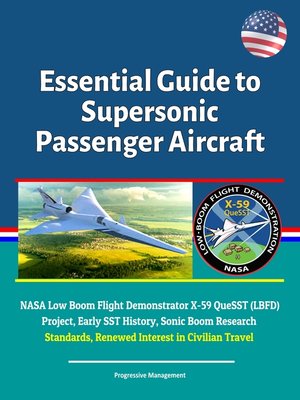Essential Guide to Supersonic Passenger Aircraft
ebook ∣ NASA Low Boom Flight Demonstrator X-59 QueSST (LBFD) Project, Early SST History, Sonic Boom Research, Standards, Renewed Interest in Civilian Travel

Sign up to save your library
With an OverDrive account, you can save your favorite libraries for at-a-glance information about availability. Find out more about OverDrive accounts.
Find this title in Libby, the library reading app by OverDrive.



Search for a digital library with this title
Title found at these libraries:
| Library Name | Distance |
|---|---|
| Loading... |
Professionally converted for accurate flowing-text e-book format reproduction, this unique book reproduces important NASA, FAA, and other government documents, reports, and studies about the history and current state of supersonic passenger aircraft and SST travel. Updated through June 2019 with the latest information, there is extensive technical coverage of the ongoing NASA Low Boom Flight Demonstrator X-59 QueSST (LBFD) Project, a new X-plane that will test its quiet supersonic technologies by flying over communities in the United States. X-59 is designed so that when flying supersonic, people on the ground will hear nothing more than a quiet sonic thump – if anything at all.
Contents: NASA Low Boom Flight Demonstrator X-59 QueSST (LBFD) Project * Part One: Overview * Part Two: Budget Presentation * Part Three: X-59 Life Support and Crew Escape System Design Challenges * Part 4: Zoom without the Boom * Part 5: Human Response to Sonic Booms * Part 6: Supersonic Passenger Flights / 2018 Research Report * Part 7: FAA Fact Sheet – Supersonic Flight * Part 8: What Happened to the American SST?
Four decades have passed since the first trans-oceanic supersonic passenger flight took off from London Heathrow Airport in 1976. Subsequently, more than 2.5 million passengers flew supersonically until British Airways and Air France took the Concorde out of service in 2003. Although no supersonic passenger aircraft have flown since then, aviation enthusiasts, aircraft and parts manufacturers, airlines, and some Members of Congress have expressed interest in restarting supersonic air travel. Several U.S. startup companies are now developing supersonic commercial and business jets. The major issues affecting the introduction of supersonic aircraft appear to remain the same as in the Concorde era—how to translate technological advances into commercial ventures that are economically viable and acceptable to regulators and the public. Gaining international consensus and approvals to fly supersonically over other countries besides the United States may be a critical element in determining the market viability of future civil supersonic aircraft designs. International agreements would also need to address permissible conditions for supersonic flight operations over water and over polar regions that have opened up to civil aircraft operations over the past decade and offer shorter flights between the United States and Asia.
Companies currently developing SSTs have stated that they envision flight ranges of about 4,000 to 6,000 nautical miles. These ranges would comfortably allow for flights between much of the east coast of the United States and key European destinations like London and Paris, with typical time savings of around two hours. However, several trans-Pacific routes, routes from western U.S. cities to Europe, and flights from the United States to Africa or the Middle East would require refueling stops. Developers envision that, even with hour-long service stops to take on fuel, the time savings could be substantial, typically cutting about one-third off of total travel time.
The revival of interest in supersonic aircraft is the result of technological advances in materials, airframe and engine designs, and aircraft manufacturing that would be able to give the aircraft longer range through improved fuel efficiency and substantial weight savings with advanced composites and aerodynamics. Denver-based Boom Technology has announced plans to test a supersonic 2-seat demonstrator by the end of 2019, and aims to deliver its first supersonic aircraft to an airline as early as 2025. In November 2016, Virgin Group, an airline operator, took purchase...







